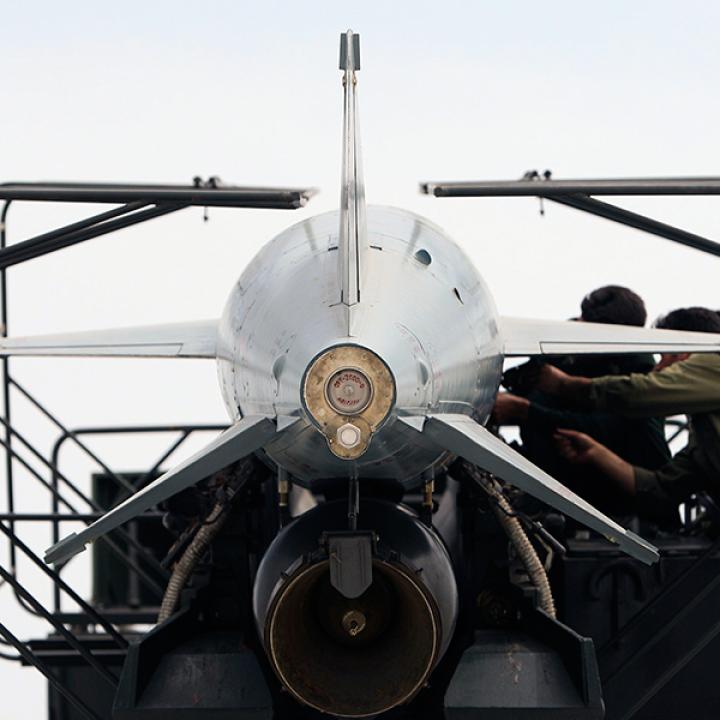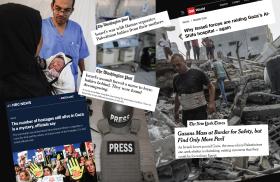
- Policy Analysis
- PolicyWatch 3943
Why Israel Should Focus on Iranian Military and Security Targets, Not Oil Infrastructure

Despite significant vulnerabilities, the redundancies in Iran’s energy production would limit the effects of any strike, while the consequences for Israeli, Gulf, and global energy markets could be significant.
On September 29, when the Israeli Air Force bombed Houthi oil infrastructure in Yemen for the second time since July, observers asserted that the distance of over a thousand miles to the targets was a warning to Iran, whose major oil fields are even closer. There are additional indications Israel might be considering strikes against Iran’s oil and gas industries after promising a major response to Iran’s massive ballistic missile attack on October 1.
But how vulnerable is Iran’s oil industry? The country can draw on vast experience maintaining production and export capacities in the 1980s during the economically destructive Iran-Iraq War. For Israel, this sector is obviously a rich set of targets, but given the effects such a strike could have on its own infrastructure—not to mention regional and global energy markets—it might be better off considering other targets.
Oil/Gas Production and Exports
Iran’s main vulnerabilities are its pumping stations, pipeline junctions, and terminal facilities. One particular junction north of Kharg Island, for example, is a coastal convergence point for all the pipelines in southwest Iran, where the country’s main oil fields are located.
Iran’s crude oil production currently stands at around 3.95 million barrels per day (mb/d), a recovery from reductions in previous years resulting from sanctions. Of this, about 2 to 2.4 mb/d are used as refinery feedstock for domestic use and the rest is exported. Iran’s crude oil exports reached 1.82 mb/d in March, mostly going to China.
Iran is also the third-largest natural gas producer in the world at around 684 million cubic meters per day (mcm/d), but is also a net gas importer because much of its output is used domestically for electricity generation and heating. During the cold season, Iranian household gas consumption can reach as high as 700 mcm/d, leading to acute shortages. On October 1, Iran signed a long-term “strategic agreement” with Russia’s Gazprom under which it will receive 300 mcm/d of gas through a pipeline that Moscow plans to build under the Caspian Sea.
Refining
Iran operates no fewer than twenty-eight oil, condensate, and gas refineries scattered all over the country. The largest is the Persian Gulf Star gas condensate refinery west of Bandar Abbas, close to the Strait of Hormuz, which was built and is partially operated by the Islamic Revolutionary Guard Corps (IRGC). This facility has a throughput of 480,000 b/d of condensate, which is about 19 percent of the country’s entire daily refinery feedstock.
Iran also operates about sixty petrochemical plants, some of which can be reconfigured to produce gasoline in times of emergency. Low prices at the pump mean that Iran is also one of the world’s biggest gasoline-consuming nations, and its automobiles are among the least fuel-efficient anywhere.
Iran is not known to be a major exporter of refined oil products, though there are some exceptions, and it does export to allied countries such as Syria and Venezuela. In addition, there is widespread smuggling of refined oil products, particularly cheap gasoline and diesel, to neighboring countries in the Gulf region. Estimates vary between 10 million liters per day of gasoline and 15 ml/d of diesel, which accounts for around 8.7 percent and 13.6 percent of Iran’s total gasoline and diesel production, respectively.
Export Terminals and Storage
Kharg Island in the northern Persian Gulf is Iran’s main crude oil export terminal, with a current loading capacity of about 5 mb/d (the country’s total capacity is 7 mb/d). It takes its crude oil supply via five submarine pipelines from the mainland and has a storage capacity of 28 million barrels (about 26 percent of Iran’s entire crude storage capacity). Kharg can load up to eleven tankers and supertankers simultaneously.
Large aboveground tanks store between 50 to 60 percent of Iran’s oil and product storage and are highly vulnerable to missile, drone, and air attacks. An estimated 5 to 10 percent of the country’s stored crude oil may also be in floating storage at any given time depending on demand (it was around 29 mb in August). Iran also has a limited number of underground storage facilities at Marun and Goreh, which are generally safer from hostile action. Iran’s long-term plans call for an increase in storage capacity to 15 billion liters of oil products and 100 mb of crude oil, including 10 mb in strategic reserves. Additionally, it has 15 billion cubic meters of natural gas in two heavily fortified underground storage sites at Sarajeh near Qom and Shourijeh near Shiraz, in order to secure supplies for the cold season.
Vulnerabilities
Iran’s oil sector, under years of sanctions and lack of foreign investment, faces difficulty in obtaining critical spare parts and modern technologies to support and modernize its infrastructure. Adding to its vulnerability is the concentration of key oil facilities in Khuzestan province, Kharg Island, and the Persian Gulf, including refineries in Bandar Abbas and Asaluyeh,
However, a successful attack on the Goreh pumping station or the Genaveh pipeline junction, for example, could severely disrupt Iran’s oil transportation to both Kharg and the new 1 mb/d Jask terminal just outside the Strait of Hormuz, since the facility pumps oil collected from Iran’s southwestern fields to both export terminals. A lack of alternatives to a damaged Goreh would force Iran to rely solely on offshore production (about 600,000 b/d) as well as existing stocks for as long as repairs are underway.
Major destruction of key pipelines, onshore and offshore production units, loading terminals, pumping stations, and pipeline junctions could disrupt Iranian oil flows for weeks or even months, though this outcome would require a substantial military effort using powerful high-precision standoff weapons, loitering drones, or sabotage. Iran’s air defenses are substantial, but they are more concentrated in certain high-priority areas such as Kharg, Bandar Abbas, and Asaluyeh, leaving other oil-related facilities less protected or unprotected.
Cyberattacks could also disrupt the control systems of refineries, pipelines, and export terminals, leading to shutdowns or damage that require extensive repairs. In recent years, Iran’s oil infrastructure was repeatedly subjected to sabotage and cyberattacks, including a complex attack against two gas pipelines in Fars province this February. In addition, in 2021 and again in 2023, Iran’s fuel distribution network was allegedly targeted by Israeli cyberattacks that disrupted nationwide gasoline supplies for weeks. The attacks affected thousands of gas stations, causing long lines, and the system remained down for several days each time.
Consequences for the Gulf, Israel, and Global Markets
Heightened geopolitical tensions in the Middle East have already led to increased oil prices, which had been in the low $70s per barrel but reached over $80 on October 7. Saudi Arabia needs a comparatively high price, perhaps $100 per barrel, for Crown Prince Muhammad bin Salman’s ambitious Vision 2030 development projects. However, such projects also depend on regional peace and stability, which explains perceived Saudi reluctance to being dragged into a wider Middle East war.
Theoretically, Riyadh could make up any shortfall in world oil supply caused by an Israeli attack on Iran’s infrastructure. But the kingdom’s main oil fields and installations lie directly across the Gulf from Iran and are therefore very vulnerable to attack (see the September 2019 strike on the Abqaiq processing complex) or sabotage.
Moreover, any Israeli strikes against Iran’s oil, gas, and petrochemical industries would likely result in Iranian and proxy attempts to attack major Israeli energy targets. These include its refineries at Haifa and Ashdod, its largest power and water desalination plants, and its three offshore gas fields.
Further escalation could also lead to direct threats against Gulf Cooperation Council oil facilities, disruption of commercial shipping through the region, and/or threatening behavior against Western naval assets. Iran has previously threatened to close the Strait of Hormuz if it can no longer export its oil, but any such disruption in retaliation for an Israeli attack would almost surely spur further Western involvement—a prospect that Tehran might want to avoid. In contrast, targeting just a few Iranian refineries or storage tanks is unlikely to trigger a major reaction other than a few missile strikes on similar Israeli facilities.
Elsewhere, Turkey and Iraq still import natural gas from Iran, and those imports are vital for their electricity generation and heating. Any disruption in Iran’s gas output would affect both countries.
Conclusion
Building on President Biden’s remarks on October 4, in which he discouraged attacks on Iran’s oil facilities, the administration should continue dissuading Israel from striking such targets. Israel would yield better effects by concentrating any attack on a single regime military, security, or intelligence organization, especially the IRGC or Basij security headquarters, or a facility that directly supports Iran’s missile program, regional proxy operations, or oppression of its own people. Singling out a regime target would present the least risk of escalation to all-out war, and may not hold as many risks for regional and global energy supplies either.
Farzin Nadimi is a senior fellow with The Washington Institute. Simon Henderson is the Institute’s Baker Senior Fellow and director of its Bernstein Program on Gulf and Energy Policy.




